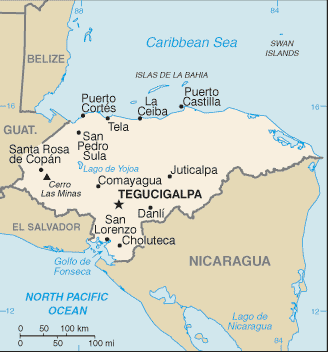|
Honduras
|

|
Capital: Tegucigalpa
Population: 9,746,117
Brief History of Honduras:
The land of Honduras was inhabited by Native American tribes. From 250AD to 900AD was the peak of the Mayan civilization. There were the most advanced and powerful of the indigenous peoples although their power had diminished by the time the Europeans arrived. Later the Lenca peoples would try to mount an organized resistance against the Spanish conquerors, but would eventually fail.
In 1502 Christopher Columbus first sighted Honduras and claimed the land for Spain. Later explorers would arrive and eventually Hernan Cortes would establish a government in the city of Trujillo.
In 1821 Honduras became an independent country. For a short time it was part of the Mexican Empire and then a part of the United Provinces of Central America before again becoming its own independent nation.
In 1998 Hurricane Mitch did terrible damage to the country. Over 5000 people died in the disaster and Honduras was devastated.
The Geography of Honduras
Total Size: 112,090 square km
Size Comparison: slightly larger than Tennessee
Geographical Coordinates: 15 00 N, 86 30 W
World Region or Continent: Central America
General Terrain: mostly mountains in interior, narrow coastal plains
Geographical Low Point: Caribbean Sea 0 m
Geographical High Point: Cerro Las Minas 2,870 m
Climate: subtropical in lowlands, temperate in mountains
Major cities: TEGUCIGALPA (capital) 1 million (2009), San Pedro Sula, Choloma
The People of Honduras
Type of Government: democratic constitutional republic
Languages Spoken: Spanish, Amerindian dialects
Independence: 15 September 1821 (from Spain)
National Holiday: Independence Day, 15 September (1821)
Nationality: Honduran(s)
Religions: Roman Catholic 97%, Protestant 3%
National Symbol: scarlet macaw; white-tailed deer
National Anthem or Song: Himno Nacional de Honduras (National Anthem of Honduras)
Economy of Honduras
Major Industries: sugar, coffee, textiles, clothing, wood products
Agricultural Products: bananas, coffee, citrus; beef; timber; shrimp
Natural Resources: timber, gold, silver, copper, lead, zinc, iron ore, antimony, coal, fish, hydropower
Major Exports: coffee, shrimp, bananas, gold, palm oil, fruit, lobster, lumber
Major Imports: machinery and transport equipment, industrial raw materials, chemical products, fuels, foodstuffs (2000)
Currency: lempira (HNL)
National GDP: $35,700,000,000
** Source for population (2012 est.) and GDP (2011 est.) is CIA World Factbook.
Back to Geography Home Page
